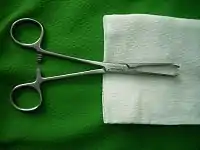Allis clamp
An Allis clamp (also called the Allis forceps) is a commonly used surgical instrument.
- The Allis clamp is a surgical instrument with sharp teeth, used to hold or grasp heavy tissue. It is also used to grasp fascia and soft tissues such as breast or bowel tissue.[1] Allis clamps can cause damage, so they are often used in tissue about to be removed.
- When used to grasp the cervix to stabilize the uterus, such as when an intrauterine device is being inserted, an Allis clamp has the advantage of causing less bleeding than the more commonly used tenaculum.[2]

Brief Biography of Oscar H. Allis
Oscar Huntingdon Allis was born on 9 September 1838 in Holley, New York. He obtained his AB in 1864 and his MA in 1865 from Lafayette College in Easton, Pennsylvania. In 1866, he graduated from Jefferson Medical College in Philadelphia and took internship at Philadelphia General Hospital.
In 1871, Allis became the original staff surgeon at Presbyterian Hospital of Philadelphia, now Penn Presbyterian Medical Center. While there, he made two major contributions to medicine: the “Allis inhaler,” at the time a safer and more convenient way to administer general anesthesia with ether or chloroform to surgical patients, and the Allis forceps, which is well-known and still used by surgeons today.
In 1885, Allis was elected to Jefferson College Board of Trustees. During this same period, he became teacher of orthopedics at Jefferson, a fellow of the Academy of Surgery, and a member of the American Surgical Association. Pediatricians still use the Allis sign (also called Galeazzi test) to assess for hip dysplasia. It is performed by flexing an infant's knees when they are lying down so that the feet touch the surface and the ankles touch the buttocks. If the knees are not level then the test is positive, indicating a potential congenital hip malformation.
Allis received the Samuel D. Gross Prize and $1000 from the Philadelphia Academy of Surgery in 1895 for his groundbreaking work on reduction of hip dislocations. In 1902, he was one of the first surgeons to describe successful bowel anastomosis. To this day, bowel surgeons use Allis clamps while performing this procedure. In the same year, a Philadelphia newspaper called him the “Father of Orthopedic Surgery at Jefferson College.” He received an honorary LL.D. from Lafayette University in 1909.
On 24 October 1877, Allis married Julia Thompson (1843-1912). One of their children Oswald Thompson Allis (1880-1973), a famed scholar and teacher of the Old Testament and co-founder of Westminster Theological Seminary in Glenside, Pennsylvania.
On 15 April 1912, Julia died. Nine years later on 16 May 1921, Oscar Allis, MD, LL.D., died at his home at 1604 Spruce Street, Philadelphia, of cerebral hemorrhage; he was 85 years old. Three days later he was interred at Laurel Hill Cemetery, Philadelphia, Pennsylvania, Section T, Plot 224, next to Julia.
See also
References
- Yap, L.H.; Ahmad, T. (2001). "Allis forceps: notes on the inventor". British Journal of Plastic Surgery. 54 (6): 561. doi:10.1054/bjps.2001.3641. PMID 11513536.
- Johnson, Lee; Johnson, Isaiah (May 2015). "Allis Compared With Tenaculum for Stabilization of the Cervix During IUD Placement: A Randomized Controlled Trial". Obstetrics & Gynecology. doi:10.1097/01.AOG.0000463550.01588.fd.
External links
| Wikimedia Commons has media related to Allis forceps. |
